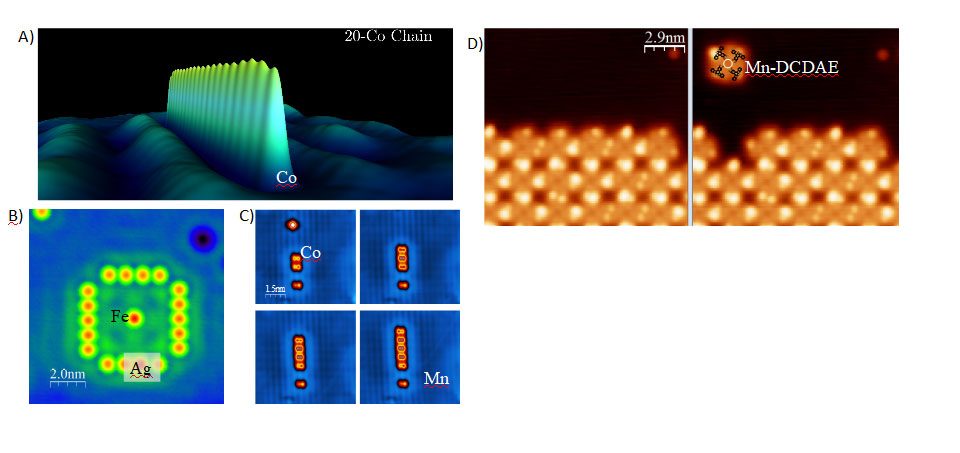ATOMIC MANIPULATION
Since the early 90s when the IBM team built the company’s logo using Xe atoms, a lot of cutting-edge experiments have been performed on structures built in an atom-by-atom fashion. At ELECMI-LMA, researchers can enter the field of atomic scale engineering, creating artificial model structures that cannot be tested by other means. In the JT-STM, the key features of SP-STM and sub-meV energy resolution meet with the possibility of creating your samples by positioning atoms and molecules with the STM tip almost at will. In this way, numberless academic models can be materialized in real world. Here you can find just a few examples of what can be done:
- Panel A shows a chain of Co atoms spaced every 0.6 nm, which is the first finite array of magnetic impurities in the Kondo lattice regime ever built.
- The quantum corral in panel B was built with Ag atoms extracted from the substrate and space every 0.9 nm. A single Fe atom lies in the centre, whose magnetic properties are tuned by the interference of free electrons trapped inside the corral (greenish oscillations).
- The manipulation processes can be done while preserving the spin sensitivity of the STM tip. Panel C shows the construction of a Co atom chain (spacing 0.6 nm) over a Mn antiferromagnetic monolayer on W(110), using a Fe-coated tip. The stripped pattern in the Mn surface corresponds to alternating rows of spin-up and spin-down atoms. The different appearance of Co atoms is due to the atomic orbitals the spin-up states are mainly of s and pz orbital character (thus their round shape in planar view), while the spin-down states are mainly dxz type orbitals (thus their double lobe appearance).
- Our manipulation expertise goes beyond moving single atoms on metallic surfaces. Larger structures like nanographenes, single molecules or coordination complexes can be relocated at precise positions of the surface. Panel D shows the extraction from a self-assembled island of an individual coordinated tetramer consisting in 4 dicyano-diarylethilene molecules (molecular scheme superposed), and one Mn atom (white circle). In our facilities, researchers can also profit from our recently developed strategies for atomic manipulation on insulating surfaces such as MgO, Cu2N and NaCl.






